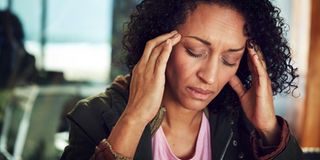Treat stroke with the emergency it deserves

High blood pressure, according to Dr Kwarisiima, is the leading cause of stroke. PHOTO | ILLUSTRATIVE | COURTESY
What you need to know:
- October 29 is International Stroke Awareness Day with focus on the importance of knowing the signs and symptoms of stroke. Anyone, no matter their age, can suffer from stroke with one in every four adults experiencing at least one episode of stroke in their lifetime.
Elizabeth Ssemigga, 56, has had persistent high blood pressure for more than 10 years. In June 2018, she felt dizziness and loss of coordination but since she was home alone, she sat on the sofa and blacked out. When one of her children returned from school later in the evening, she tried to wake her up but she was not responding.
“By the time we took her to hospital, her limbs were paralysed and she could not speak. The doctor said she had suffered a stroke whose effects would be permanent since there had been a delay in seeking medical attention. Until now, she walks with a limp and her speech is unclear,” her daughter says.
Dr Joel Kiryabwire, a neurosurgeon and president of the Neurosurgical Society of Uganda, notes that over the last 10 years, there has been a 30 percent increase in the number of stroke cases and currently, stroke is the sixth commonest cause of death in Uganda
Stroke is one of top five leading causes of deaths in adults in Uganda and accounts for 3.7 percent of all hospital admissions, according to Dr Barbra Kakande, a cardiologist at UMC Victoria Hospital. About 30 to 40 percent of admitted stroke patients die in Uganda. Blocked vessels account for 80 percent of all the stroke cases.
A stroke, also known as a brain attack, is a medical condition where blood supply to a part of the brain is interrupted suddenly by a blockage or rupture of a blood vessel leading to leakage of blood into the brain tissue.
What really happens?
As a result, Dr Kakande says, “the brain cells die when they do not receive oxygen or nutrients, which are supplied through the blood. There are two types of stroke; ischemic stroke caused by a blockage of a blood vessel supplying the brain and hemorrhagic stroke, which is caused by bleeding into the brain from a ruptured vessel and can be diagnosed using a brain CT scan.”
A stroke usually happens because the blood flow may be disrupted since the wall of the blood vessels gets damaged progressively for a long period of time by conditions such as high blood pressure and high cholesterol, or because of an acute event, such as an infection. Also, blood clots from the heart can be transported to the brain and block the flow through narrower blood vessels. Parts of the brain get injured or even die.
Signs and symptoms
The symptoms of a stroke are usually sudden and they usually depend on the size of the affected blood vessel. Dr Levi Kwarisiima, a cardiologist at Mulago national Referral Hospital, says depending on the part of the brain affected, patients present differently, along a spectrum including one not having any symptoms or signs, some losing the ability to perform a particular function or set of functions and some even die.
The different parts of the brain have different functions. This means that the patient will have different symptoms, depending on the part of the brain that is injured. A person may present with one or a combination of the following:
● Sudden numbness or weakness, especially on one side of the body and the face (facial asymmetry).
● Confusion or difficulty in speaking or understanding speech.
● Sudden difficulty in seeing in one or both eyes.
● Sudden dizziness, or loss of balance or coordination.
● Sudden severe headache with no known cause.
● Unconsciousness.
● Loss of speech.
It is important that you seek medical attention even if it is a false alarm since many times, people report to hospital when it is too late.
Causes and risk factors
Although there are some health conditions that predispose someone to developing a stroke, most of the factors that increase risk are lifestyle-related and can be easily controlled.
High blood pressure, according to Dr Kwarisiima, is the leading cause of stroke. Others include obesity, diabetes Mellitus both types I and II, high blood cholesterol, cigarette smoking, heavy alcohol consumption, lack of regular exercise, a diet high in fat and salt and less fruits and vegetables.
There are some risk factors that are not modifiable and one may not have control over them according to Dr Sanmath Shetty, a consultant cardiologist at Kisubi Hospital. He says, “As one grows older, their risk of developing a stroke also increases. Other risk factors include irregular beating of the heart, a condition referred to as atrial fibrillation, sickle cell disease, heart diseases which causes clots in the left side of the heart or blood clots from other parts of the body passing through small holes in the heart from the right to the left heart to the brain.”
Infections and inflammation can weaken or damage brain blood vessels. Some people are born with "weak" blood vessels that, in the brain, develop tears and other abnormalities, resulting in leaking of blood into the brain.
Dr Kakande remarks that there are some types of medications, including blood thinners that can also cause strokes. People living with sickle cell disease can have a stroke as a complication resulting from sickled red blood cells clogging blood vessels.
Treatment and prevention
Dr Shetty says, “Stroke is a medical emergency and the affected person should be taken to hospital as soon as possible.”
Treatment involves giving medicine that helps dissolve the clot that may have caused a blockage for ischemic strokes to increase blood supply and treat the underlying causes (risk factors) such as uncontrolled blood pressure to prevent further occurrence of the stroke.
“Drugs to break the clot can be given only if the patient comes within four and a half hours of the start of stroke symptoms. If successful, this treatment may completely reverse the weakness and prevent permanent paralysis,” Dr Kakande says.
The best way to prevent stroke is to prevent the risk factors, especially those that are modifiable by lifestyle change such as a healthy diet, regular exercise, avoiding smoking, and alcohol consumption. Certain medications such as blood thinners (aspirin) and cholesterol reducing medications (statins) can help prevent further stroke episodes after the first episode.
Dr Kiryabwire advises people to make exercise a part of their lifestyle in order to reduce the risks of developing stroke. A healthy diet is also essential in the prevention of strokes.
“Avoid a lot of cholesterol intake, fat, too much salt as well as junk food,” he says, adding that one should regularly see a doctor for medical checkup so that if there is anything detectable, it can be treated early enough.
Complications
There are some after effects of stroke such as permanent weakness or paralysis of the affected limbs, infections such as pneumonia due to aspiration of saliva into the lungs, urinary tract infections, bedsores, swallowing and speech problems and seizures due to abnormal electrical activity in the brain.
This is the reason Dr Kwarisiima recommends anti-depressants and physiotherapy for people who have suffered stroke. This is because such people usually become depressed, especially if they are unable to do things that they used to do.




